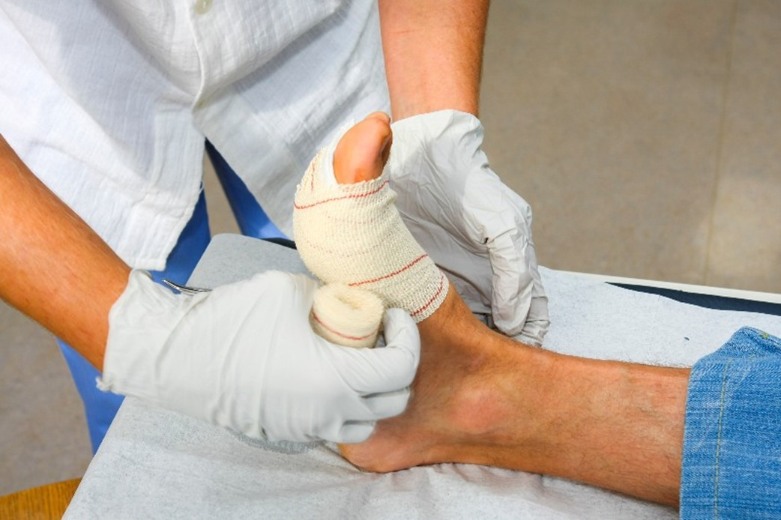Arterial Wound Care Demystified: Understanding Evaluation Procedures and Management Strategies
The Importance of Proper Arterial Wound Care
Over six million people in the United States are living with chronic wounds, and many of those wounds are caused by peripheral arterial disease. The arterial ulcers resulting from this disease are painful skin wounds, typically on the lower leg, and these ulcers can form from something as minimal as a small injury. Without the proper arterial wound care, serious complications can ensue, including infection, tissue necrosis, and even amputation. That is why proper arterial wound care management is so crucial.
Arterial Wound Care: Evaluation
The first step in properly treating a wound is correctly identifying it. Arterial wounds have very distinctive symptoms, like a “punched out” appearance in which the sore has well-defined margins but is deeper in the skin than the healthy tissue around it. The sore itself may be black, grey, brown or yellow, and may not bleed, but can be quite painful. The pain may be less when the legs are hanging from the bed, and patients often sleep in a chair to lessen the pain. Arterial wounds often appear on bony parts of the foot like the toes or the heels, and the wound site is typically cool, due to a lack of blood circulation. The limb that has the ulcer may have minimal hair growth, and may appear pale when propped or elevated but red when dangled. Dangerous symptoms to watch for include fever, discharge, numbness, or a foul odor. If you have any of these symptoms, it is extremely important to seek care from a wound care specialist or another medical professional, to avoid severe complications, including amputation.
Who is at Risk of Arterial Wounds?
The primary causes of arterial wounds are blocked or damaged arteries. However, some people are at higher risk for these wounds than others. Middle-aged men are more likely to suffer from arterial wounds, as are people who smoke, are of African American ancestry, have a family history of arterial wounds, have endured a trauma, have limited mobility, or suffer from conditions that include:
- Diabetes
- Hypertension
- Dyslipidemia
- High cholesterol
- High blood pressure
- Sickle cell disease
- Atherosclerosis
- Buerger’s disease
- Vasculitis
- Peripheral vascular disease
- Kidney disease
What is an Arterial Ulcer?
This type of wound occurs when an artery in the leg becomes blocked or damaged, causing poor blood circulation that prevents the delivery of oxygen and nutrients to the leg tissue. Often, these wounds are referred to as ischemic ulcers, because ischemic refers to restricted blood and oxygen. Allowed to continue, this poor circulation causes the skin and underlying tissue to begin to die, and that is what causes arterial wounds to form. Once the wound has formed, the poor circulation will result in slow healing and a heightened risk of infection. It is sometimes difficult to differentiate between an arterial ulcer and a venous ulcer, because each type of wound occurs on the lower extremities, and they share some characteristics. However, arterial ulcers typically occur on the outer side of the feet, ankles, heels, or toes, while venous ulcers tend to affect the inner ankle or the area below the knee. Additionally, venous ulcers have more variation in how they look, as opposed to arterial ulcers, which have distinct discoloration and a punched out appearance. Venous ulcers may be painless, unless they are affected, while arterial ulcers are typically painful or uncomfortable, and venous ulcers often cause weeping or edema, but arterial ulcers do not. It is important to identify which kind of wound is being treated, because the two are treated quite differently. Compression therapy is the primary treatment for venous wounds, while surgery and other interventions are more common for arterial wounds.
Arterial Wound Management Strategies
Sometimes, arterial wounds heal on their own. However, this can take a long time, because of the poor circulation to the area. It is vital that you seek the care of a wound specialist, because proper diagnosis and treatment are essential for healing arterial ulcers. There are some basic principles to apply on your own, though, which can help you manage arterial wounds. Increasing your physical activity can help increase circulation and reduce pain, and quitting smoking can slow the progression of peripheral vascular disease and decrease the likelihood of arterial wounds. Eating a nutrient-dense diet can promote healing, and checking your legs and feet regularly for any new sores can help prevent them from becoming severe. Compression therapy should always be avoided with arterial wounds, because blood and oxygen are already in short supply in the affected area, and compression can further block blood flow.
Arterial Wound Care Procedures
Your specialist can determine the best course of action in treating your arterial wounds, starting with the proper bandages and dressings. Special shoes and orthopedic devices may be recommended, to relieve pressure on the sore. Your healthcare provider may prescribe antibiotics or other medications, or may recommend surgical options like angioplasty or bypass.
Arterial Wound Care from Arizona Vein & Laser Institute
If you’re seeking arterial wound care or help with other vein issues, trust the board-certified physicians at the Arizona Vein & Laser Institute. Using the most advanced technology, the vascular and cardiovascular surgeons at the Arizona Vein & Laser Institute provide care for all types of venous diseases. With over 40 years of experience, our team of experienced physicians can devise the right treatment plan to address your venous disease problems. For more information contact us through our website.

